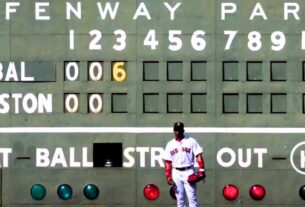The double in baseball refers to a hit that allows the batter to reach second base. This is one of the most fundamental scoring opportunities in the sport.
Known as America’s pastime, baseball combines strategy, skill, and athleticism. The double is a key component of an offensive strategy, providing significant scoring opportunities without a home run. This achievement not only demonstrates the hitter’s prowess, but also sets the stage for teammates to contribute.
By understanding the importance of a double, one can better appreciate the game’s complexities. Whether a veteran fan or newcomer, recognizing the strategic value of a double enriches the baseball experience.
What Is A Double In Baseball?
When a baseball player hits the ball and reaches second base without stopping, he has hit a double. Defining a double in baseball will help us understand it better. What Is Double Switch In Baseball?
Definition Of A Double
When a player hits the ball and reaches second base safely, it’s called a double. It happens without errors from the other team. It is important for teams to score runs with doubles. Reasons for this are as follows:
- It puts a player in scoring position: Being on second base means you’re closer to home plate.
- It shows skill: Hitting a double often requires power and precision.
Think of doubles as a big achievement for batters. They are a sign that a team is doing well in hitting.
Scoring A Double
Getting a double sounds simple, but it needs good timing and skill. Here’s how players score doubles:
- The batter hits the ball into play.
- The ball lands in a spot that makes it hard for fielders to get it quickly.
- The batter runs fast to second base before the ball can be thrown to the baseman.
Speed and smart hitting make doubles possible. They turn up the heat in games, making them more exciting.
Types Of Doubles
Doubles in baseball come in different styles. They depend on how and where the ball is hit. Here are some types:
- Ground-rule doubles: When the ball bounces out of play, it’s an automatic double.
- Gappers: These are balls hit between outfielders, landing far enough away to let the batter reach second.
- Line-drive doubles: Hard-hit balls that fly straight and land deep in the field.
Each type of double adds excitement to the game. They show the batter’s power and the team’s strategy.

Importance Of Doubles In Baseball
Baseball’s thrilling world makes doubles more than just two-base hits. It’s a game-changer that can shift the dynamics on the field. In baseball, doubles are important. They can turn a game, giving teams better chances to score. The ability to consistently hit doubles makes a hitter valuable to the team. Discover why doubles are a key component of winning strategies.
Advancing Runners
When a player hits a double, it does wonders for advancing runners on the base paths. Consider the following points:
- A double often turns singles into scores, as runners from first can usually make it home.
- Runners on second or third base are almost certain to score when a double is hit.
- It relieves pressure on the next hitters, who can now contribute with simpler hits.
Let’s look at a scenario in a table format:
| Before Double | After Double |
| Runner on First | Runner Scores |
| Runner on Second | Runner Scores |
| No Runners | Hitter on Second |
This progress puts the team in a strong position to score, showing how crucial doubles can be.
Increasing Scoring Opportunities
Doubles have a direct impact on a team’s scoring opportunities. Here’s why:
- Runners in scoring position: A double puts a runner on second, ready to score on a single.
- Pressure on the defense: The opposing team must play carefully, knowing any hit could result in a run.
- More RBI chances: Batters following a double have increased chances for runs batted in (RBIs).
Teams with more doubles often see a spike in their run tally. This can be the difference between a win or a loss.
Boosting Batting Average
A batter’s average gets a significant boost from hitting doubles. Consider the benefits:
- Consistent hitting: Batters with high double counts are seen as reliable hitters.
- Higher on-base percentage: Doubles improve a player’s OBP, a key statistic for hitters.
- Slugging percentage: Doubles contribute to slugging percentage, reflecting a player’s power.
In most teams, players who hit many doubles are among the best hitters. It shows their skill in making contact and finding gaps. Clearly, doubles can be powerful tools for batters.

Famous Double Hitters In Baseball History
Nothing makes baseball more exciting than a double. Batters who reach second base safely achieve doubles. Many hitters create memorable moments by hitting doubles. Take a look at the players who master the double.
Hall Of Famers Known For Doubles
Baseball’s Hall of Fame features legends known for their ability to hit doubles. These players combined precision and power to find gaps in the outfield. Some standout names include:
- Tris Speaker – A master of the double, Speaker holds the all-time record for career doubles.
- Stan Musial – “Stan the Man” was a consistent double-hitter, known for his smooth swing.
- Pete Rose – Not in the Hall of Fame due to his ban from baseball, but Rose’s doubles record is unquestioned.
Here is a quick look at these legends’ double records:
| Player | Career Doubles |
| Tris Speaker | 792 |
| Stan Musial | 725 |
| Pete Rose | 746 |
Records For Most Doubles In A Season
Some seasons stand out for the incredible number of doubles hit. The record for most doubles in a single season is a testament to a player’s endurance and skill. A few record holders are:
- Earl Webb – Set the record with 67 doubles in 1931.
- George Burns – Hit 64 doubles in 1926.
- Joe Medwick – Tallied 64 doubles in his 1936 campaign.
Their remarkable achievements underscore the importance of doubles in scoring and game strategy. Doubles can often be game-changers, turning the tide in close contests.
Notable Players With High Double Counts
Beyond the record-breakers, many players have consistently raked in high double counts. These hitters have shown a knack for finding the right spots in the outfield. Noteworthy players include:
- Albert Pujols – His power and precision have earned him a spot among the leaders in career doubles.
- Todd Helton – Known for his ability to consistently drive the ball to the gaps.
- Paul Molitor – His speed and contact hitting made him a doubles machine.
These players displayed exceptional skill in racking up doubles, helping their teams and securing their place in baseball history.

Strategies To Hit Doubles
The double is an exciting play in baseball that thrills fans. A double occurs when a batter reaches second base safely without making a fielding error. It takes skill, practice, and a bit of strategy to hit doubles. The tactics batters use to make a great hit will be discussed.
Hitting To The Gaps
Finding the right spot in the outfield is crucial for hitting a double. The areas between outfielders, known as gaps, are prime real estate for this purpose. To successfully hit to the gaps, follow these tips:
- Study the field: Know the positions of the outfielders.
- Work on timing: Sync your swing with the pitch to drive the ball into open spaces.
- Control the bat angle: Adjust your bat to guide the ball.
Consider this table showing the benefits of hitting to the gaps:
| Benefit | Explanation |
| Extra bases | A well-placed hit allows runners to advance more than one base. |
| Scoring opportunities | Hitting to the gaps often leads to RBIs (Runs Batted In). |
| Pressure on defense | Defenders must cover more ground, increasing the chance of errors. |
Speed And Base Running Skills
While a solid hit is important, speed and base running skills are also vital. Quick runners can turn singles into doubles. To improve, work on these areas:
- Base running drills: Practice sharp turns and quick accelerations.
- Sliding technique: Learn to slide efficiently to avoid tags.
- Read the play: Anticipate the ball’s path and the fielder’s actions.
Speedy players often make the difference in tight games. Aggressive base running forces errors and creates scoring chances.
Understanding The Pitcher’s Tendencies
Knowing what the pitcher might throw can give you an edge. Study their habits and look for patterns, such as:
- Pitch selection: Notice the types of pitches thrown in different counts.
- Pitching rhythm: Detect timing patterns to anticipate the delivery.
- Signs of fatigue: Exploit slower pitches as the game progresses.
Use this information to adjust your swing and approach at the plate. This can make the difference between a routine out and a powerful double.

Fielding Challenges For Doubles
A double baseball is a hit that gets the batter to second base safely. Crowd cheers at this exciting play. Still, it poses fielding challenges. Players must act fast, think faster, and show off their skills. Here’s what makes fielding doubles so thrilling.
Positioning Of Outfielders
Outfielders are crucial to defending against doubles. The positioning of the players can make or break the play. They must stand at the perfect spot. Deep hits won’t be caught if they’re too close. Too far, and they’ll give up easy singles that could turn into doubles. Here’s what outfielders keep in mind:
- Reading the batter: Outfielders watch the batter’s stance and swing. This tip helps predict where the ball might go.
- Adjusting for the pitch: The type of pitch can change everything. Outfielders shift their feet with each throw.
- Knowing the runners: The speed of runners can affect how outfielders position themselves. They need to be ready for a fast dash to second base.
Outfielders also use a strategy based on the number of outs and the score. They keep these details in mind to stay ahead of the game.
Cutoffs And Relay Throws
Once a double is hit, the action turns to cutoffs and relays. A quick throw like this can stop a runner in their tracks. Infielders take throws from outfielders and zipping them to second. Here’s the process:
- The outfielder scoops up the ball and aims at the cutoff man.
- The cutoff man positions himself in line with the outfielder and the base.
- The relay throw must be sharp and swift. Any delay, and the runner could slide into second.
Teams practice this drill over and over. It’s all about the speed and accuracy of the throw. Get it right, and you might just save the game.
Communication And Coordination
For a play to succeed, communication and coordination are vital. Outfielders and infielders must shout out and signal to each other. They need to know who will take the ball and where it should go. Here’s what good team communication looks like:
- Calling for the ball: Players shout loud and clear to avoid collisions and mix-ups.
- Using hand signals: Sometimes, it’s too loud for voices. That’s when hand signals come into play.
- Eye contact: A quick look can say a lot. It helps players stay connected and act as one.
Every second counts. Players must speak up, sign, and look out for their teammates. This teamwork can turn a sure double into an out. It’s all about working together to outsmart the runner and shine on the field.
Conclusion
Every baseball enthusiast should understand the concept of a double. It’s a thrilling play that displays speed and skill. Knowing these fundamentals deepens our appreciation of the game. Your next ballgame is sure to feature impressive two-base hits if you keep this knowledge in your arsenal.
Read More
What is a Quality at Bat in Baseball
Baseball Force Out Vs Tag Out
What Does Tagged Out Mean in Baseball



